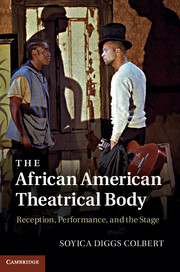Book contents
- Frontmatter
- Contents
- Illustrations
- Acknowledgements
- Overture: rites of reparation
- Chapter 1 Repetition/reproduction: the DNA of black expressive culture
- Chapter 2 Recuperating black diasporic history
- Chapter 3 Reenacting the Harlem Renaissance
- Chapter 4 Resisting shame and offering praise and worship
- Chapter 5 Resisting death: the blues bravado of a ghost
- Chapter 6 Rituals of repair
- Chapter 7 Reconstitution
- Epilogue Black movements
- Notes
- Bibliography
- Index
Chapter 1 - Repetition/reproduction: the DNA of black expressive culture
Lorraine Hansberry's A Raisin in the Sun
Published online by Cambridge University Press: 05 November 2011
- Frontmatter
- Contents
- Illustrations
- Acknowledgements
- Overture: rites of reparation
- Chapter 1 Repetition/reproduction: the DNA of black expressive culture
- Chapter 2 Recuperating black diasporic history
- Chapter 3 Reenacting the Harlem Renaissance
- Chapter 4 Resisting shame and offering praise and worship
- Chapter 5 Resisting death: the blues bravado of a ghost
- Chapter 6 Rituals of repair
- Chapter 7 Reconstitution
- Epilogue Black movements
- Notes
- Bibliography
- Index
Summary
On February 25, 2008, A Raisin in the Sun (1959) proved the lasting appeal of explosive dreaming. Through the 2008 ABC made-for-television movie production, Lorraine Hansberry's classic American drama reclaimed the national spotlight, making the play accessible to a new generation of viewers. Directed by Kenny Leon and starring Sean Combs (Walter Lee Younger), Phylicia Rashad (Lena Younger also known as Mama), Audra McDonald (Ruth Younger), and Sanaa Lathan (Beneatha Younger), the ABC production marks another milestone in the noteworthy history of the play (Figure 1). In 1959, A Raisin in the Sun debuted on Broadway with Sidney Poitier and Ruby Dee as Walter Lee and Ruth. The first play produced on Broadway that an African American woman had written, A Raisin in the Sun was nominated for four Tony Awards and won the New York Drama Critics' Award, making Hansberry the first African American and woman to win the award. Hansberry's play became a film in 1961. Robert Nemiroff adapted the play into a musical, which ran on Broadway in 1973 and won a Tony Award. In 1989, the first made-for-television movie version of the play premiered starring Danny Glover as Walter Lee. A Raisin in the Sun returned to Broadway in 2004 featuring the same cast as the 2008 production.
In each revival and adaptation of the play, the audience participates in making meaning and making history. Those acts, however, do not occur in a vacuum. Instead, they reflect the material and performance remains of prior productions, including the originating performance of a role. Although the 2004 production garnered critical acclaim, including Tony Awards for Best Performance by a Leading Actress to Phylicia Rashad, the first African American woman to win in that category, and Best Revival of a Play, many critics questioned the casting of hip-hop mogul Sean Combs as Walter Lee. I agree with Richard Zoglin's assessment of the 2004 production in Time. He judges that Combs' “expressive – now sullen, now cocky, now bitterly mocking” performance functions well in the comedic scenes, but does not “measure up . . . in the big scenes.” Lacking indeed, Combs' at times ineffectual performance allowed a version of the play to emerge that differed significantly from the 1959 production. Combs' performance fell short particularly in comparison to that of Sidney Poitier. Poitier originated the role and through it emerged as a star. As Walter Lee, Poitier transformed the dynamic of the play from Mama's story to the son's drama. The less refined Combs left comparatively more room for the women characters to shine. The 2004 production captured the drama, desire, and emotional lives of Mama, Ruth, and Beneatha. In that light, the production that resulted from the decision to cast Combs as Walter Lee suffered with Combs' acting chops, or lack thereof, as much as it benefited from the opportunity provided for the actresses to shine.
- Type
- Chapter
- Information
- The African American Theatrical BodyReception, Performance, and the Stage, pp. 20 - 47Publisher: Cambridge University PressPrint publication year: 2011



